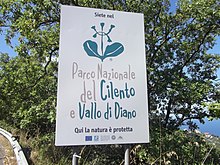The Cilento (Italian Il Cilento) is part of the Italian region of Campania. It is located about 100 km south of Naples.

In the 1990s, the area was declared a UNESCO World Heritage Site as the second largest national park in Italy (over 200,000 hectares). It is framed by the world-famous Amalfi Coast and the Costa di Maratea. Not least because of this, nature conservation plays a decisive role in the region.
The Cilento is characterized on the one hand by its diversity, on the other hand by its originality. In addition to sand and stone beaches, there are numerous bays, grottos and cliffs. At the same time, the mountains, which mostly rise behind the beaches, and thus many hiking opportunities for visitors are easy to reach. The highest mountain is Monte Cervati, located in the core zone of the national park, at 1898 meters. While other regions are massively developed for tourism, the Cilento still offers original customs and genuine regional cuisine.
getting there
The Cilento can be reached by train, car or plane. From Germany, Austria and Switzerland there are numerous night trains to the south of Italy via Rome. Those who want to travel by car use the motorway Rome - Salerno - Reggio Calabria and choose the Battipaglia exit. From here it is a good 20 kilometers to Paestum, the gateway to the Cilento. Suitable airports for air travelers are Rome, Naples or Lamezia Terme (near Tropea). In addition to using local public transport, you can also rent a car on site.
climate

The Cilento is located in the southernmost climatic zone of the country. Due to the dry winds falling from the mountains, the temperatures remain moderate even in the midsummer months; the winters are usually very mild.
The bathing season lasts from around the end of April to the beginning of November.
places
Alphabetical arrangement:
Sights and culture
The Cilento has a multitude of historical sites and cultural treasures, especially the famous Greek temples in Paestum. But also the remains of the ancient Greek city Velia With its school of philosophy at the time, well-fortified Saracen towers along the coast and the Carthusian monastery in Padula attract new visitors every year. Popular destinations are also the picturesque centers of the small towns such as Pisciotta, which is located on a hilltop, and the mountain village of Camerota in southern Italy religious customs still play a major role. Tourists can experience traditional festivities and ceremonies, such as the Good Friday processions or festivals in honor of the respective village saints, live.
Also worth seeing is the WWF oasis Morigerati with the Grotto des Bussento, the small marine museum in Pioppi as well as the Museum Virtuale Paleolitico (MUVIP) and the prehistoric grottoes in Marina di Camerota.
kitchen
Buffalo mozzarella is one of the most famous products in the region. Wine is also grown in the Cilento, with mainly small producers at work. The Cilento also developed the famous Mediterranean diet that made Ancel Keys world famous. In recent years, many producers in the region have also placed increasing emphasis on the production of organic food . The organic olive oil in the area is of the highest quality and is known far beyond the borders of southern Italy.
Due to its location by the sea, there is a long fishing tradition. Many of the dishes typical of the region therefore use fish and seafood. A special form of fishing that is still practiced here is the so-called 'alici di menaica', in which 200-meter-long, specially knotted nets (the so-called menaica) are cast. Here mainly schools of anchovies are caught.
Sports
The region is of course ideal for a beach holiday due to the many beaches. Several municipalities have been awarded the bandiera blu, the blue flag and the 5 sails of the Legambiente. Because of the excellent water quality, snorkelers also get their money's worth. Other popular activities for holidaymakers are hiking, mountain biking and horse riding.
trips
- Naples: From many places in the Cilento, Naples can be reached comfortably and inexpensively by train within 1 to 2 hours. Naples offers a lot of flair, a wide range of cultural assets and art treasures as well as a lively city life.
- Islands: The islands are located in the Gulf of Naples Ischia, Procida and that became world famous capri. These can be easily reached by ship, especially with the public Metrò del Mare.
- Vesuvius and Pompeii: For history buffs, a trip to the excavation sites in Pompeii is a must.
An excursion with the sailboat along the Cilento coast, departure e.g. from the port of Marina di Camerota - Cilento a Vela
literature
Cilento active with Costa di Maratea - active vacation in the original southern Italy, Peter Amann (2012)
Cilento - travel guide with many practical tips, Andreas Haller (2012)
Rother hiking guide Cilento: From Salerno to Sapri, 50 hiking tours, Hans M. Tuschar (2010)
Gulf of Naples: Naples, Pompeii, Capri, Ischia, the Amalfi Coast, the Cilento and much more, Peter Amann (2013)
La Cucina Cilentana - Delicacies from the Cilento cuisine, Barbara Poggi (2006)
Web links
Accommodation in the Cilento: http://www.cilento-ferien.de
Vacation rentals in the Cilento https://www.mediterraneocase.de/ferienhaus-und-ferienwohnung/im-cilento/
Tips for an active holiday in the Cilento: http://www.cilento-aktiv.info
Unknown Cilento, Focus (http://www.focus.de/reisen/italien/cilento/mittelalterliches-italien_aid_23317.html)
